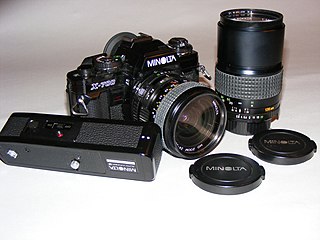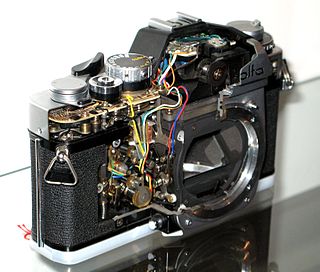
A single-lens reflex camera (SLR) is a camera that typically uses a mirror and prism system that permits the photographer to view through the lens and see exactly what will be captured. With twin lens reflex and rangefinder cameras, the viewed image could be significantly different from the final image. When the shutter button is pressed on most SLRs, the mirror flips out of the light path, allowing light to pass through to the light receptor and the image to be captured.

Minolta Co., Ltd. was a Japanese manufacturer of cameras, camera accessories, photocopiers, fax machines, and laser printers. Minolta Co., Ltd., which is also known simply as Minolta, was founded in Osaka, Japan, in 1928 as Nichi-Doku Shashinki Shōten. It made the first integrated autofocus 35 mm SLR camera system. In 1931, the company adopted its final name, an acronym for "Mechanism, Instruments, Optics, and Lenses by Tashima".

The Nikon FM is a mechanically operated, interchangeable lens, 35 mm film, single-lens reflex (SLR) camera. It was manufactured in Japan between 1977 and 1982 by Nippon Kogaku K. K..

The Nikon FA was an advanced amateur-level, interchangeable lens, 35 mm film, single-lens reflex (SLR) camera. It was manufactured by the Japanese optics company Nippon Kogaku K. K. in Japan from 1983 to 1987. The FA used a titanium-bladed, vertical-travel Nikon-designed, Copal-made focal plane shutter with a speed range of 1 to 1/4000th second plus Bulb and flash X-sync of 1/250th second. It was available in two colors: black with chrome trim and all black. The introductory US list price for the chrome body only was $646. Note that SLRs usually sold for 30 to 40 percent below list price.

The Nikon FE2 is a 35 mm single lens reflex (SLR) camera manufactured by Nippon Kogaku K. K. in Japan from 1983 to 1987. The FE2 used a Nikon-designed vertical-travel focal-plane shutter with a speed range of 8 to 1/4000th second, plus Bulb and flash X-sync of 1/250th second. It has dimensions of 90 millimetres (3.5 in) height, 142.5 mm (5.61 in) width, 57.5 mm (2.26 in) depth and 550 grams (19 oz) weight, and was available in two colors: black with chrome trim and all black. The introductory US list price for the chrome body only was $446. Note that SLRs usually sold for 30 to 40 percent below list price.

The Nikon FE is an advanced semi-professional level, interchangeable lens, 35 mm film, single-lens reflex (SLR) camera. It was manufactured by Nikon in Japan from 1978 to 1983, and was available new from dealer stock until c. 1984. The FE uses a metal-bladed, vertical-travel focal plane shutter with a speed range of 8 to 1/1000 second, plus Bulb, and flash X-sync of 1/125th second. It had dimensions of 89.5 millimetres (3.52 in) height, 142 mm (5.6 in) width, 57.5 mm (2.26 in) depth and 590 grams (21 oz) weight. It was available in two colors: black with chrome trim and all black. As on the FM, its model designation did not appear on the front of the camera, but was engraved as a small "FE" preceding the serial number on the rear of the housing.

The Canonflex is a Canon 35 mm film single-lens reflex (SLR) camera introduced in May 1959. Its standard lens is the Canon Camera Co. Super-Canomatic R 50mm lens f/1.8. The camera was in production for one year before it was replaced by the Canonflex R2000, adding a 1/2000 sec. shutter speed.

Nikkormat was a brand of cameras produced by the Japanese optics company Nippon Kogaku K. K., as a consumer version of the professional Nikon brand. Nikkormat cameras, produced from 1965 until 1978, were simpler and more affordable than Nikon-branded cameras, but accepted the same lenses as the Nikon F series cameras.

The Minolta X-700 is a 35 mm single-lens reflex film camera introduced by Minolta in 1981. It was the top model of their final manual-focus SLR series before the introduction of the auto-focus Minolta Maxxum 7000.

The Minolta SR-T 101 is a 35mm manual focus SLR camera with Through-The-Lens exposure metering – TTL for short - that was launched in 1966 by Minolta Camera Co. It was aimed at demanding amateur and semi-professional photographers. The SR-T 101 stayed in production for ten years with only minor changes.

The Minolta A-mount camera system was a line of photographic equipment from Minolta introduced in 1985 with the world's first integrated autofocus system in the camera body with interchangeable lenses. The system used a lens mount called A-mount, with a flange focal distance 44.50 mm, one millimeter longer, 43.5 mm, than the previous SR mount from 1958. The new mount was wider, 49.7 mm vs. 44.97 mm, than the older SR-mount and had a longer flange focal distance making old manual lenses incompatible with the new system. Minolta bought the autofocus technology of Leica Correfot camera which was partly used on the a-mount autofocus technology. The mount is now used by Sony, who bought the SLR camera division from Konica Minolta, Konica and Minolta having merged a few years before.
Originally produced by Minolta, then by Sony, the AF Reflex 500mm f/8 was a catadioptric photographic lens compatible with cameras using the Minolta A-mount and Sony A-mount lens mounts.

The Konica Hexar RF is a 35 mm rangefinder camera which was sold by Konica. It was introduced to the market on 13 October 1999. and subsequently discontinued some time before the end of 2003. The camera used the "Bayonet Konica KM-mount", a copy of the Leica M-mount, thus sharing interchangeable lenses with those designed for Leica cameras and others compatible with them. The Hexar RF has a combined rangefinder/viewfinder modeled on that of Leica cameras, a similar body shape and size - and so is similar to Leica M-mount cameras in many aspects of operation.

The Minolta CLE is a TTL-metering automatic exposure aperture-priority 35 mm rangefinder camera using Leica M lenses, introduced by Minolta in 1980.

The Minolta 9000 AF is a professional Single-lens reflex autofocus camera, introduced by Minolta in August 1985. It was both Minolta's and the world's first professional autofocus SLR. It was called Minolta Maxxum 9000 in the US and Minolta α-9000 in Japan.

The Minolta SR-mount was the bayonet mounting system used in all 35 mm SLR cameras made by Minolta with interchangeable manual focusing lenses. Several iterations of the mounting were produced over the decades, and as a result, the mount itself was sometimes referred to by the name of the corresponding lens generation instead.

The Minolta-35 was launched in the spring of 1947 by Chiyoda Kogaku. It was the first successful new 35mm rangefinder camera with Leica specifications to emerge on the market after World War II that uses the 39mm screw lens-mount. The Minolta-35 range of cameras was manufactured in quantities during its twelve-year production period, totalling about 40,000 units. Only the 1933 FED and the 1940 Leotax cameras had appeared successfully before it, although several Leica copies had appeared in both Italy and Japan.
Minolta mount may refer to:

Rokkor was a brand name used for all Chiyoda Kōgaku Seikō and later Minolta lenses between 1940 and 1980, including a few, which were marketed and sold by other companies like Leica. The name was derived from the name of Rokkō (六甲山), a 932 metre (3058') high mountain, which could be seen from the company's glass-making and optics factory at Mukogawa near Osaka, Japan. The company's founder Kazuo Tashima wanted the name to symbolize the high quality in optics.

The Minolta SR-7 is a 35 mm single-lens reflex camera (SLR) made by Minolta, produced from 1962 to 1966. It is notable for being the first SLR camera with a built in CdS light meter.


















